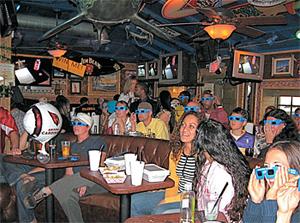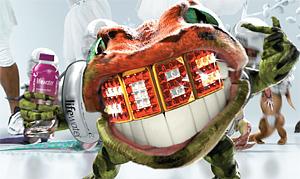3D Ads Break New Ground

Did the universe change for you at the end of the first half of February's Super Bowl XLIII? Perhaps not, but if you had been cool enough to have equipped yourself and your party mates with some of the 125 million special glasses given out nationwide by SoBe Lifewater (and sold on eBay), you would have seen the first televised 3D presentation using only a single image that could even be appreciated on standard definition TV screens. The 3D effect during the PepsiCo and Paramount DreamWorks spots may not have been perfect, but it was definitely clever.
COLORCODE 3D
There is one point that needs to be clarified right up front, however. Although the cardboard glasses had lenses of different colors, this was not a traditional anaglyph process as has been so widely misreported. Anaglyph separates the left and right eye images with colored lenses of red and blue (or cyan or green) to present the 3D effect. ColorCode 3D is a spectrum analysis process far more sophisticated than anaglyph, that comes much closer to presenting full color imagery.
As Svend B. Sorensen, CEO and the inventor of the ColorCode 3D system explains, the amber (left) lens conveys the color by using complex spectral curves while the blue (right) lens gives the brain the parallax information that simulates the perception of 3D depth on the Z axis.

Most of the crowd at Baja Sharkeez in Manhattan Beach, Calif., watched 3D ads during the Super Bowl. "It is based on an alternative color theory called 'retinex' formulated in 1971 by Edwin H. Land of Polaroid fame," Sorensen said. "It claims that by using both a long wave and a short wave filter you can generate all colors except purple, and I've been working to implement this into the ColorCode 3D system ever since I stumbled across this principle when I was a student at the Technical University of Denmark. Since then it has been used in, among other projects, four IMAX movies and now for the ads seen during Super Bowl XLIII."
If you still have your special glasses, you can see the best presentation of ColorCode 3D and the Super Bowl ads on their Web site at www.colorcode3d.com.
As opposed to the other major 3D systems gaining popularity in digital cinema theaters such as RealD, Dolby Digital 3D or IMAX 3D, ColorCode 3D is not a stereographic system since the left and right "eyes" have been combined into a single image. That's why those ads could be viewed in 3D even though there was only one image on the TV screen. After all, at a cost of $1 million every 10 seconds, the advertisers did not want to alienate viewers who missed the glasses offer.
So utilizing ColorCode 3D was a calculated compromise on the part of the advertisers and NBC.
"We fully acknowledge that the high-end systems are the best for theatrical use," Sorensen said. "However, our ColorCode 3D approach is much more universally applicable since it requires no special hardware for viewers. It may also be useful in establishing 3D theaters in less affluent countries that cannot afford the full stereographic approaches."
LIZARD LAKE
The DreamWorks promo for the March 27 release of "Monsters vs. Aliens" was based on their theatrical trailer, but the spot for SoBe Lifewater was a true crossover event titled "3D Lizard Lake." It was directed by Peter Arnell combining characters like Insectosaurus, Ginormica and Dr. Cockroach, Ph.D from the movie cavorting with the SoBe Lizards and NFL stars including New England Patriots' Matt Light and Baltimore Ravens' Ray Lewis dancing to the tunes of Swan Lake.
This broke new ground for everyone involved, especially Jay Barton, visual effects supervisor at the Academy Award-winning digital production studio Digital Domain in Venice, Calif.

SoBe Lifewater "3D Lizard Lake" ad "This was mostly a green screen shoot, but we only had the NFL stars for one day and that was without the other background dancers or stunt doubles," Barton said. "So we had to accomplish some very accurate tracking with the 3ality Digital camera rigs we were using on the first day with the football players and then accurately match the camera movements the next day with the rest of the cast. Eventually we just started locking off the 3D cameras at the point of convergence. Then director Arnell very creatively matched the action from various elements so we could composite the left and right eyes in stereo 3D space."
Editor Alex Hagon from the editorial post house Final Cut USA was on the set using a laptop ironically loaded with Avid Media Composer software (the company was named before Apple's NLE came out) to help Arnell keep track of continuity. They could watch 3D takes on the set using polarized glasses, and then check the composites with LCD shutter glasses back at Digital Domain.
"'3D Lizard Lake' was my first 3D ad," Hagon said, "but I learned a great deal. For example, if you are doing a lot of jump cuts it can be more jarring to the eye in 3D than it would be in 2D. And you have to be very aware of where the points of convergence between left and right eye are placed so you can maintain a visual sense of depth continuity. Director Arnell and I were constantly checking the results in a 3D theater during editing because he likes to keep the creativity very fluid during the post-production process."
As it turned out Hagon was still working with the director and the VFX folks at Digital Domain right up to a little more than a week before the Super Bowl broadcast. But he feels that showing the SoBe Lifewater ad to millions of people in ColorCode 3D was a worthwhile experiment.
TAKING A GAMBLE
It was a bit more of a gamble using ColorCode 3D on a promo for a megabucks movie like "Monsters vs. Aliens." That spot was mostly cut from the theatrical trailer by editors at DreamWorks but the TV run was not what digital cinema audiences will see with stereographic systems like RealD 3D.
"We're excited millions of viewers got a glimpse of 3D during the Super Bowl," said Michael V. Lewis, chairman and CEO of RealD. "But it's important to recognize that today's RealD 3D in theaters is a quantum leap better than what they saw on TV or may remember from years past. We can't wait for audiences to see the real thing in a RealD 3D theatre."
There is one more bit of football-related 3D news that should be reported. Most of the reviews of last January's BCS championship game presented in 3D in 82 theaters around the country have reflected the enthusiasm of the companies behind that experiment. Yes, it utilized the robust RealD polarized 3D process and despite some technical glitches the depth effect was impressive for an early attempt at a live broadcast.
However, when I witnessed the event at Grauman's Chinese Theatre in Hollywood—despite the fact the game was tied at the end of the first half and the sold out crowd had plunked down $21 for a ticket—when the third quarter started, less than half the seats were filled.
Jay Ankeney is a freelance editor and post-production consultant based in Los Angeles. Write him at 220 39th St. (upper), Manhattan Beach, CA 90266 or atJayAnkeney@mac.com.
Get the TV Tech Newsletter
The professional video industry's #1 source for news, trends and product and tech information. Sign up below.
